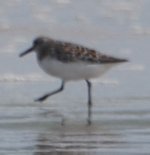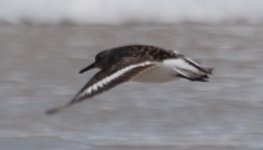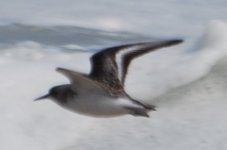Looks like a Sanderling to me, but Sibley's range map shows them as a winter bird on the east coast.
Agree on Sanderling. Looking over my Sibley's, it looks like several other of the shorebird range maps are also like that (including, for example, Ruddy Turnstone, Red Knot, and Dunlin). In fact, all my guides (National Geographic, National Wildlife Federation) have maps like those. I would consider all those maps to be incorrect, and find them rather puzzling. Such birds certainly can be present in winter, but most are also definitely present during migration, and in fact most of the year (as noted above). My Massachusetts Audubon Society checklist gives the following dates of regular occurrence for these species in Massachusetts:
Sanderling: Second week of July through the first week of June (so only "absent" in the latter part of June and beginning of July), with scattered reports throughout the year
Dunlin: Fourth week of July through fourth week of May (so only "absent" in June, July, and the beginning of August), with scattered reports throughout the year
Ruddy Turnstone: Second week of May through first week of June, second week of July through third week of October, with scattered reports throughout the year
Red Knot: Third week of May through the first week of June, and second week of July through last week of October, with scattered reports throughout the year
Hopefully, you can find some similar information for your local area.
Best,
Jim







